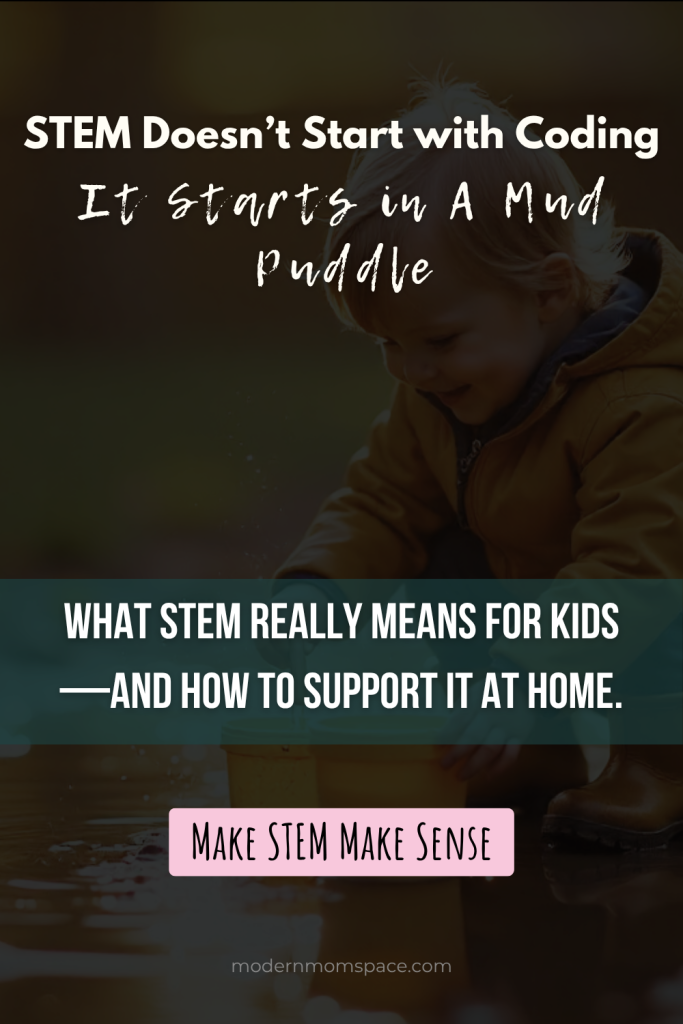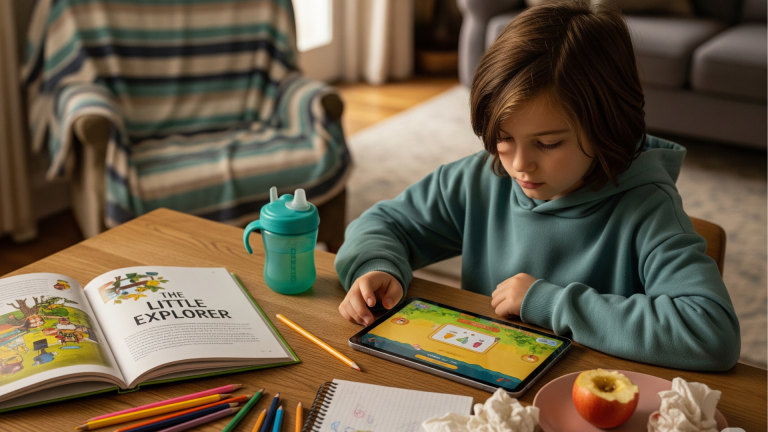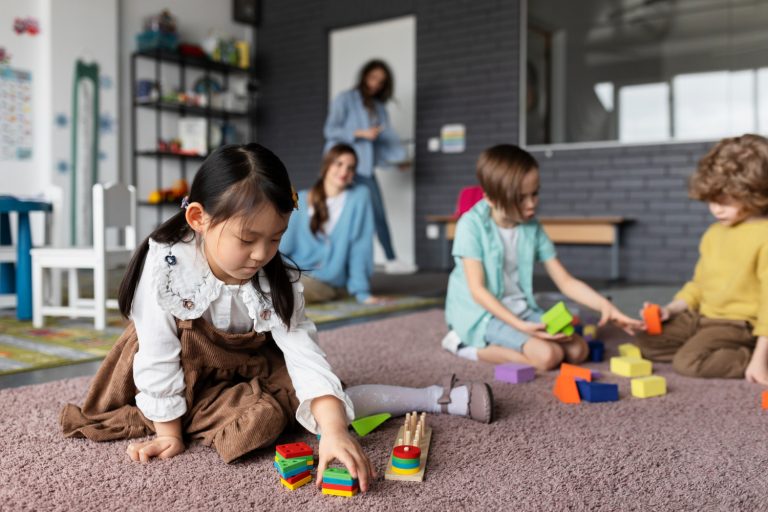What Is STEM? (And Why It Matters for Your Kid)
Picture this. Your kid is stacking couch cushions into a teetering, wobbling tower. You’re two seconds from stopping the chaos — but wait.
They adjust, test weight, re-balance.
They’re not just playing. They’re engineering.
STEM isn’t a subject. It’s a mindset.
It’s not just something kids learn at school. It’s something they do — every time they build, explore, test, tinker, or ask, “Why did that happen?”
But here’s where most parents get tripped up:
They hear “STEM” and think it’s all about coding bootcamps, pricey robotics kits, or prepping their 6-year-old to become a software engineer.
It’s not. And that narrow view is exactly why a lot of kids — especially the ones who could really thrive in STEM — start to tune out early.
STEM is for every kid.
Yes, the future job market will demand it. But more importantly, it builds critical life skills now:
So whether your child is into art, animals, stories, science, or slime — STEM can shape how they see and engage with the world.
And it doesn’t start in high school. It starts way earlier — in your living room, your kitchen, your backyard.
You don’t need a teaching degree or a tech background. You just need to understand what STEM really is (and isn’t) — and how to make it part of your child’s world.
Let’s break it down.
What Does STEM Actually Mean?
Here’s the truth no one puts on the toy box:
Your kid can do STEM without touching a single screen.
Let’s unpack what STEM actually means — and why it’s not just about coding, calculators, or science fairs.
STEM = Science, Technology, Engineering, Math
But not in the dry, textbook way you might remember from school.
STEM is a hands-on, brains-on approach to understanding and solving real-world problems.
Think of it like this:
🧪 Science
STEM science isn’t just test tubes. It’s cause and effect. It’s observation.
At home, that looks like:
Your kid doesn’t need to memorize the water cycle to be “doing science.” They just need to notice, ask, and explore.
🖥️ Technology
Not just screens. Technology is anything humans make to solve a problem.
Examples:
It’s not about knowing how an app works. It’s about realizing tools exist — and figuring out how to use them creatively.
🏗️ Engineering
Engineering is problem-solving through design, testing, and building.
You’ll see it when your kid:
They don’t have to call it “engineering.” They’re doing it already.
➕ Math
Not just arithmetic. Math is logic, patterns, quantities, and spatial thinking.
At home, this could be:
Every time they compare, count, or predict — they’re using math.
So Why Does This Matter?
Because when you broaden your definition of STEM, you unlock hundreds of chances every week for your child to build these skills — no worksheets required.
When they:
They’re not “just playing.”
They’re building the mindset that helps them think, adapt, and create.
Why STEM Matters — Even If Your Kid Isn’t “Into Science”
Let’s say your kid never becomes an engineer.
Never touches a microscope.
Never codes a single line.So… was STEM a waste of time?
Not even close.
STEM isn’t about raising the next Elon Musk.
It’s about raising kids who can handle a world that’s changing fast — where answers aren’t always obvious and problems don’t come with instructions.
Here’s why STEM matters for every kid — artsy, outdoorsy, techy, shy, loud, all of them.
1. It builds real-world problem-solvers
STEM teaches kids how to ask better questions, try different solutions, and keep going when the first one doesn’t work.
These are the exact skills that help them:
It’s not about memorizing facts. It’s about learning how to think.
2. It trains their brain to embrace failure
In STEM, failure isn’t a dead end — it’s part of the process.
That’s powerful for kids.
Instead of avoiding hard things, they learn:
That kind of resilience? It spills into everything.
3. It fuels creativity — not just logic
We tend to divide kids into “creative” vs “logical,” but STEM is both.
Creativity is essential to problem-solving — and STEM gives kids the tools to bring their ideas to life.
4. It builds confidence through doing
When kids tinker, test, adjust, and finally get something to work? That’s empowering.
They don’t need a grade or a gold star. They get internal feedback:
And unlike many school subjects, STEM gives instant feedback — either the bridge stands or it falls.
5. It prepares them for a future we can’t predict
Let’s be blunt: your kid is going to live in a world shaped by tech, automation, climate shifts, and industries that haven’t even been invented yet.
According to the U.S. Bureau of Labor Statistics, STEM jobs are projected to grow nearly twice as fast as non-STEM jobs in the next decade.
[BLS, 2022–2032]
Even if they don’t go into a STEM career, the skills are transferable:
These are what future employers — and life — will demand.
So no, your child doesn’t need to “be into science” for STEM to matter.
They just need space to explore, build, and think in new ways.
When Should STEM Start? (Earlier Than You Think)

STEM doesn’t start with a laptop.
It starts with a puddle.
If you’re picturing STEM as a subject that kicks in around middle school — once kids can handle equations and science labs — you’re way too late.
The truth? Kids are natural STEM thinkers from the time they can hold a spoon and bang it on a pot.
They observe. They test. They repeat. They problem-solve without even realizing it.
Young Brains Are Built for STEM
According to the Harvard Center on the Developing Child, early STEM experiences — especially hands-on play — help build brain architecture for focus, reasoning, and math.
Here’s what the research shows:
In short: the earlier kids dive into STEM, the more they build the mental muscles for school, problem-solving, and lifelong curiosity.
(Source: Harvard Center on the Developing Child)
And No, It Doesn’t Look Like “School”
When you hear “early STEM,” don’t think worksheets, lectures, or math drills. Think:
STEM in early childhood is play-based. It’s messy. It’s hands-on. And it’s how kids make sense of the world.
Parents Sometimes Wait Too Long — Here’s Why That’s a Problem
Waiting until 3rd or 4th grade for formal STEM lessons might seem fine — but it often backfires.
Research from the University of Washington found that by age six, many girls are already less likely to believe STEM is “for them” — not because of ability, but because of subtle early messages they’ve absorbed.
By the time STEM shows up in the classroom as a formal subject, some kids have already decided:
“I’m not a science kid.”
“I’m not good at math.”
“This isn’t fun.”
And those early beliefs? They can stick for life.
(Source: University of Washington – Kids, teens believe girls aren’t interested in computer science)
You Can Start Sooner Than You Think
You don’t need a curriculum. You need:
You’re not “teaching STEM.” You’re protecting the kind of thinking your kid already does naturally — and helping it grow.
STEM at Home — What It Looks Like by Age

You don’t need a science kit to “do STEM.”
You need a curious kid and whatever’s already in your house.
Parents often ask:
“How do I actually do STEM at home?”
The answer changes depending on your child’s age — but it always starts with play, questions, and trial-and-error.
Here’s how STEM shows up in everyday life, from toddlers to tweens.
👶 Toddlers & Preschoolers (Ages 1–5)
Goal: Build curiosity, pattern recognition, and motor skills through play.
STEM looks like:
No-prep ideas:
Tip: Resist the urge to jump in. Let them experiment and “fail.” That’s the learning.
Looking for hands-on toys that do exactly this? Check out these Montessori-style picks under $30.
🧒 Early Elementary (Ages 6–9)
Goal: Strengthen logic, build on natural curiosity, and introduce problem-solving challenges.
STEM looks like:
No-prep ideas:
App-based options (if allowed):
👦🏽 Tweens (Ages 10–12)
Goal: Deepen problem-solving, explore real-world applications, and nurture creative independence.
STEM looks like:
No-prep ideas:
App-based tools (if screen time is part of your routine):
Not all screen time supports real learning — this guide helps you tell the difference.
📝 Screen-Free + App-Based = Both Can Work
Don’t feel like you have to choose one or the other.
The key is balance:
Use tech when it enhances curiosity — not replaces it.
Quick Recap Checklist:
Common Parent Questions — and Honest Answers
Let’s get real.
You want to support your kid’s learning — but you don’t want to become a full-time activity director or drop $300 on a robot kit they’ll use twice.
Totally fair.
You’ve probably had at least one of these questions. So let’s clear things up, no fluff.
❓“What if I’m not good at math or science?”
You don’t need to be. Your job isn’t to be the expert — it’s to be curious alongside your kid.
Try saying:
That alone models the exact mindset STEM is built on: problem-solving and experimentation.
❓“Can STEM be screen-free?”
Absolutely. It should be, at least some of the time.
Screens can be useful tools (when used with intention), but core STEM skills — like testing, building, observing, and predicting — start with real, physical experiences.
Think: cardboard, water, magnets, marbles, dirt.
If you’re using apps or tech tools for STEM, you’ll also want screen-time boundaries that actually stick — this guide walks you through it.
❓“Do I need to buy a bunch of STEM kits?”
Nope. The best STEM learning happens through:
STEM kits can be fun if your kid is into them — but they’re not necessary. In fact, over-structured kits can actually limit creative problem-solving if they’re too prescriptive.
Want low-cost options that actually help your kid learn? These Montessori picks build real STEM skills—without breaking $30.
❓“My kid hates math. Is STEM even worth trying?”
STEM isn’t just math class.
It’s logic, creativity, persistence, and hands-on learning — all of which can reframe how kids feel about math when they stop seeing it as just worksheets and grades.
Let them:
They’ll be doing math without realizing it.
❓“What if my child just doesn’t seem interested in STEM?”
They probably are — just not in the way you expect.
Instead of pushing traditional STEM topics, try:
The goal is to help them think like a problem-solver, not memorize a science textbook.
Bottom line: You don’t need to have all the answers. You just need to stay curious, create space for exploration, and trust that the learning is happening — even when it’s messy.
Easy Ways to Support STEM Thinking at Home
No lesson plans.
No perfect Pinterest setups.
No pressure to become “that mom.”
Just a few small shifts — in how you talk, how you play, and how you respond — can build a strong STEM mindset in your kid.
Here’s how to support it without turning your home into a science lab.
✅ 1. Ask Open-Ended Questions
Skip “yes or no” questions. Instead, try:
This teaches your kid to think, not just guess.
Why it works: It keeps them in explorer mode, not “get the right answer” mode.
✅ 2. Let Them Make Mistakes (and Try Again)
Don’t fix their block tower the moment it falls. Don’t jump in with the answer.
Let them:
Why it matters: STEM learning thrives on failure. Every “oops” is an opportunity.
✅ 3. Give Them “Tinker Time”
Kids need unstructured time to explore and experiment.
Why it works: This builds design thinking and problem-solving without any pressure.
✅ 4. Turn Everyday Moments Into STEM Moments
You don’t need extra hours in your day. Just reframe what’s already happening.
Examples:
Why it works: Kids learn best when it’s real. No lesson required.
✅ 5. Use Toys and Books That Invite Exploration
You don’t need “STEM-branded” toys — just ones that let kids build, test, and figure things out.
Good picks:
Why it works: The more they engage with problems in play, the more confident they become in solving them elsewhere.
Here’s a list of Montessori-inspired toys that do just that—sorted by age and all under $30.
✅ 6. Model Curiosity
Be the kind of adult who says:
Why it matters: Your mindset rubs off. If you approach problems with curiosity, they will too.
Quick Wins Summary (Checklist Graphic Option):
You don’t need a STEM degree.
You just need to stay curious, slow down, and make space for your kid to explore.
Final Takeaway — It’s Not About STEM Careers, It’s About STEM Mindsets
Forget the job title.
Focus on the mindset.
Yes, STEM jobs are growing. Yes, future employers will want those skills.
But that’s not the point of raising STEM-literate kids.
The real win?
Your child learns how to:
Those aren’t just STEM skills. They’re life skills. And they’re in short supply.
You’re Not Behind. You’re Already Doing More Than You Think.
If your kid builds, asks “why?”, fiddles with tape and cardboard, or mixes things in the kitchen “just to see what happens” — that’s STEM.
If you’ve ever said, “Hmm, let’s find out together” — you’re already setting the tone.
You don’t need perfect setups. You don’t need hours of free time.
You just need to:
That’s how STEM thinking grows — not through pressure or perfection, but through space, questions, and trust.
Final Words to Parents:
Start small. Stay curious. Keep it messy.
That’s more than enough.
Save it. Share it. Send it.
Found this guide helpful?
Save it for those days when you want to support your kid’s learning but don’t have time to plan anything.
Share it in your parenting group chat.
Or send it to a friend who thinks “STEM” means buying another overpriced toy.STEM doesn’t have to be complicated. It just has to start. Let’s help each other raise curious, confident problem-solvers.








